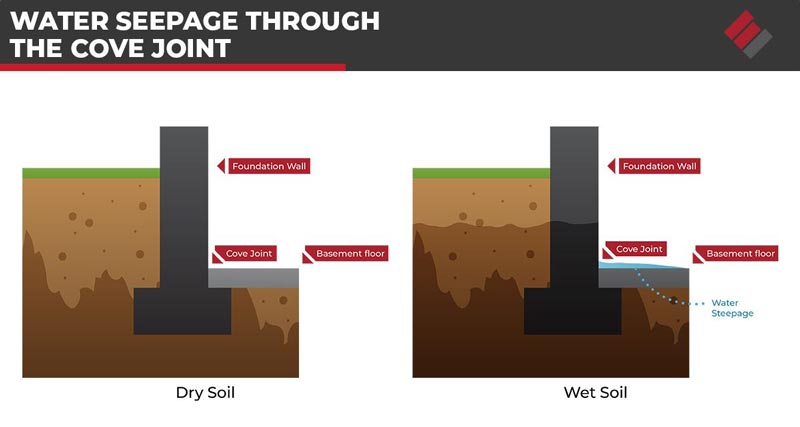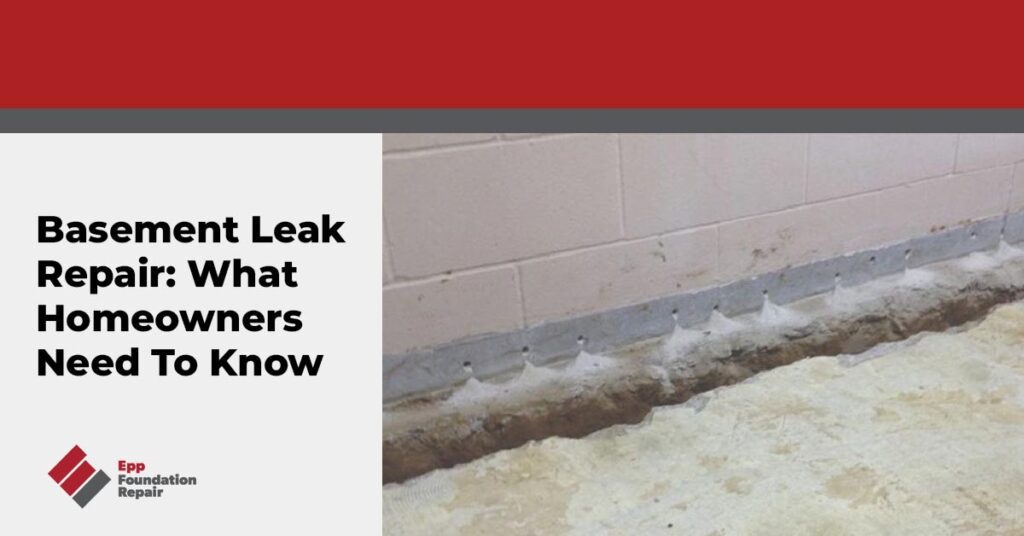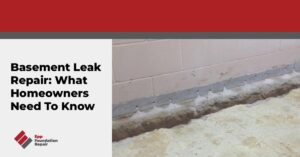Looking for information about basement leak repair? If so, you’ve landed on the right page because that’s what this article is about. We’re going to cover why it’s important to find out where the water is coming from, how water leaks through basement walls, basement leak repair, and more.
Where Is The Water Coming From?
Water in a basement could be coming from various places, including:
- Cracks in the basement (i.e., foundation) wall – These cracks might be so small that you don’t even see them. However, water always finds a way in.
- Cracks in the basement floor – Water can also seep through invisible cracks in the basement floor.
- Water leakage under and around the basement door
- Leaky window wells – If there isn’t good drainage in the window wells, water could eventually find its way into the basement through an egress window..
Hydrostatic Pressure
Before we talk about how water leaks into basements, we need to discuss hydrostatic pressure.
Hydrostatic pressure happens when there’s excess moisture in the ground around the foundation and no way for it to drain off. Hydrostatic pressure is bad because it exerts a tremendous force against the basement (i.e., foundation) walls. If hydrostatic pressure isn’t promptly relieved, the wall will eventually start to bow inward and even crack.
Proper basement waterproofing ensures that hydrostatic pressure can’t build up in the soil around the foundation. We’ll talk more about this in just a bit.
How Water Leaks In Through Basement Walls
Basement (i.e., foundation) walls are the most common area for leaks. When hydrostatic pressure builds up outside the foundation wall, it’s able to push water through the wall and into the basement in the following ways:
- Through cracks in a basement wall caused by hydrostatic pressure
- Through the cove joint – This is the space between the floor and the wall.
- Through a deteriorating concrete foundation wall – Concrete can deteriorate for various reasons. If this happens, water will have an easier way of leaking through the wall.
- Over-the-top leakage – Water can also seep through the space between the top of the basement wall and the ground floor.

Basement Leak Repair – Basement Waterproofing
You can use epoxy crack injection or polyurethane foam injection to seal cracks in a foundation wall. That’s a temporary fix that will buy you some time. However, it’s not a long-term basement waterproofing solution on its own because it doesn’t solve the root problem, which is excess water in the soil around the foundation and the resulting build-up of hydrostatic pressure. For that, you need a drain tile system.
Drain Tile System – The Ultimate Waterproofing Solution
A drain tile system is a gold standard for basement waterproofing. There is no better way to prevent water from leaking into your basement than a drain tile system.
There are two types of drain tile systems, exterior and interior. Here’s how they work:
Exterior Drain Tile System
An exterior drain tile system is installed around the outside perimeter of the foundation at the footing level.
- The first step in installing an exterior drain tile system is excavating around the outside perimeter of the foundation down to the footing.
- A shallow trench is dug around the perimeter and lined with gravel.
- A perforated drainage pipe is placed into the trench and covered with more gravel.
- The excavated soil is replaced.
Excess moisture in the ground flows into the drainage pipe and toward a sump pit. Once the pit fills with water, a sump pump turns on and ejects the water a safe distance from the foundation.
Interior Drain Tile System
An interior drain tile system is installed around the inside perimeter of the basement. Installing an interior drain tile system means tearing up a section of the basement floor.
- The first step in installing an interior drain tile system in a basement involves tearing up the floor along the inside perimeter of the basement.
- Next, a shallow trench is dug and lined with gravel.
- The drainage pipe is placed into the trench and covered with more gravel.
Excess water flows into the drainage pipe and makes its way toward the sump pit. When the water in the sump pit reaches a certain level, the sump pump kicks in and expels the water away from the foundation.
Signs You Might Need Basement Leak Repair
Signs your home might need basement leak repair include the following:
- Visible mold
- Musty smell, including a musty smell inside the home’s living are
- Water trickling down walls or pooled on the floor
- High humidity
- Wood rot on any wooden structures in the basement
- Water damage
Other Ways To Keep Water Out Of Your Basement
The best way to keep water out of your basement is to install a drain tile system. However, if that’s not in your budget right now, you can do some other things. The following are recommended even if you have a drain tile system installed:
- Regrade your yard, so it slopes away from the foundation – If the yard slopes toward the house, water will drain toward the foundation and soak into the soil.
- Don’t plant water-hungry vegetation next to the house. The flowers and shrubs might look nice, but they need water.
- If your downspouts release water next to the foundation, install downspout extensions. They’re inexpensive and will carry water away from the foundation before releasing it.
- Install an underground downspout and pop-up emitter – Runoff flows into the underground downspout and toward the pop-up emitter situated in your yard approximately 10 feet from the foundation. When the emitter fills with water, it pops up and releases the water away from the foundation.
- Clean your gutters regularly – Gutters clogged with dead leaves and other debris can cause water to spill over the side of the home and soak the ground around the foundation.
If you think your home might need basement leak repair, contact us today to schedule an appointment. We serve areas in Lincoln, Omaha, Grand Island, Kearney, Nebraska, Missouri, Iowa and parts of Northeastern Kansas. For more information, see our Service Area page.







